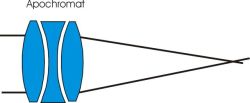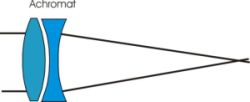The refractor
|
The refractor is the classic telescope design that most people are familiar with: A long thin tube that points to the sky with a focuser at the bottom end that you look through. There are basically two different types:
Both of which, as regarding their construction, are in principle very simple systems. The Galilean system consists of a converging lens at the front and a diverging lens at the back. This type of system is used mainly in opera glasses. However, since the exit pupil lies inside the tube (i.e. in front of the diverging lens), it produces a small field of view which is rather diffuse at the edge. It is intended only for low magnifications. But the advantage is that it provides an upright image. The Keplerian telescopeThe Keplerian telescope is also referred to as an astronomical telescope. As with the Galilean system, it has a converging lens at the front. At the rear, however, it uses a converging lens instead. This serves as the eyepiece. The Keplerian telescope produces an upside-down image. It forms an intermediate image at the focal point. The focus of the lens coincides with the focal point of the eyepiece. The eyepiece, which consists of a single converging lens, produces an enlarged image of the intermediate image. These ‘normal’ refractors that used to be used have one major drawback: they suffer from chromatic aberration. This means that the light of different wavelengths come to a focus at different distances. Blue light is refracted more strongly through the lens than red light for example. This produces irritating colour fringing around objects observed through the telescope. And if you want to magnify an image further, then this colour fringing will get even worse. This fringing also has an extremely detrimental effect on the image contrast of a refractor. The optical solution to colour fringingA method was discovered to minimize this effect by building a new design of telescope known as an ‘achromatic’. An achromatic lens consists not of one, but two lens elements combined together, usually consisting of a crown glass element and a flint glass element, which work together as ‘plus’ and ‘minus’ elements and which are known together as an ‘achromatic doublet’. These lenses consist of a convex (outer part) and concave (inner part) element. The refraction index (by how much light is bent) and the dispersion (by how much light is scattered) of each lens element is different. This allows most colour aberrations to be cancelled out. Nevertheless, there is still a little colour fringing left, known as ‘secondary spectrum’. When buying an apochromatic telescope today, you will find that there are two different types available: 1. Doublet ED apochromats ED apochromats are come as instruments with two or three lens elements. One lens element will always made from ED glass, which takes care of eliminating chromatic aberration in the entire lens system. Two lens ED apochromats correct for the majority of chromatic aberration, but cannot completely eliminate it. For this reason, some amateur astronomers refer to these telescopes as ‘semi-apos’. Three-lens ED apochromats eliminate colour aberrations almost completely. The image they produce is not only clear and colour-neutral, but also of very high contrast. |
|
|
Achromat: Consists of two lens elements - of flint and crown glass. These lenses are generally arranged so that there is an air gap, but there are also cemented systems. ED apochromat: This system is basically an achromat, with one lens element made of ED glass. These also have an air gap. The colour aberration is almost entirely corrected for. Fluorite-apo: This consists of two lens elements cemented together, one of which is made of fluorite. This produces a similar effect to using an ED glass element. Apochromat: This system is a full apochromat, whereas the two preceding systems are both referred to as semi-apos. It typically consists of three lens elements. Chromatic aberration is virtually entirely corrected for. For some time now, so-called ‘superapochromats’ have also been available. This type of refractor consists of five lens elements, generally arranged in two groups. The first group of three lens elements perform the same function as a triplet apochromat. The second group of two lens elements correct for field curvature with the aim of being able to producing perfect astronomy photographs.
The other solutionAnother method of reducing chromatic aberration in refractors is that one designs refractors with the smallest possible aperture ratio. This means that these telescopes must have long focal lengths. This has the effect of also reducing chromatic aberration. A general rule of thumb states that the focal length of these achromats should be fifteen times their objective lens diameters in order to get a decently clean image colour. This would, however, with a 100mm refractor mean a focal length of 1500mm as f=1:15. In even larger refractors, the focal length would have to be even longer. This would mean very long, unwieldy refractors, which would be unacceptable. Another acceptable formula would be: focal length in cm = aperture in cm². This is a compromise, but is still in order. A 100mm refractor would then have a focal length of 1000mm and a 120mm refractor would have a focal length of just under 1500mm.
Outwitting chromatic aberrationWhat should you do if you have a lens telescope which has chromatic aberration? Scrap it and buy a new one? No, you don’t have go that far as, fortunately, there are ways of reducing this. If a small amount of colour fringing irritates you, then you can, for example, use a minus-violet filter. This suppresses the blue colour fringe while increasing contrast. However, the image is not quite neutral, but appears slightly yellowish. Even so, detail is improved. The minus-violet filter is a classical version, but there are now other filters that will also do the job. One specially developed filter is the Baader Fringe Killer. It blocks around 50% of the blue light component, but allows the red and green light through. The intelligent design means that light loss is limited to only 12%. This hence allows you to confidently use this filter even with smaller refractors. Another filter is the so-called Semi APO filter. This is a quite a cool product name, but does it do the job? Take a refractor with a short focal length - of perhaps 500mm. You can see a thick blue fringe around bright objects. What happens to the fringe if you screw a Semi APO filter into the eyepiece? The fringe around bright objects simply disappears. The image appears even more colour-neutral than with the Fringekiller. However, the light loss with the Semi APO filter is higher - approximately 30%. The advantage is that the image appears very colour-neutral with this filter. For smaller refractors it is better to use the Fringekiller, but with refractors from about 100-120mm the Semi APO filter is well worth the money. The refractor is a great instrument, if it is properly colour corrected. But large refractors, even though they collect a lot of light, are relatively expensive and bulky. So now let us take a look at mirror telescopes. |
|


